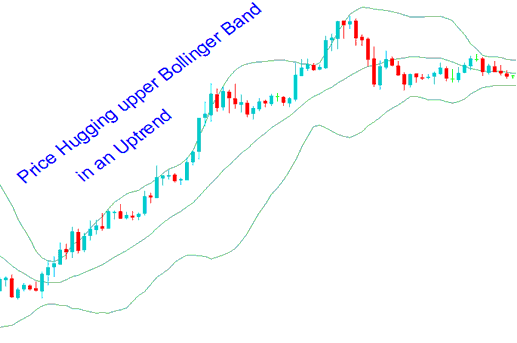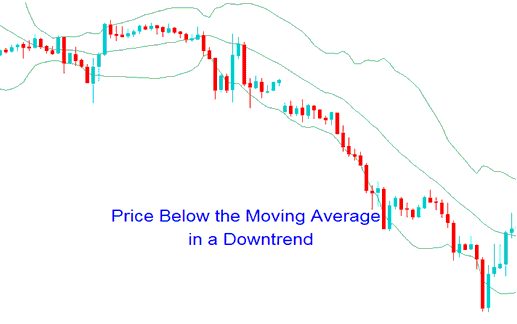Bollinger Band Gold Price Action in Trending Markets
The Bollinger Band indicator is employed to identify and analyze trending markets: in a trending market, this gold indicator distinctly indicates upward or downward directions.
Bollinger Band technical indicator can be used to determine the direction of the XAUUSD trend. In an upward trend Bollinger Bands indicator will clearly show the direction of the price trend, it will be heading upwards & price will be above middle Bollinger.
In a downward gold trend, the price will dip below the middle band, while the bands will direct downwards.
Watch Bollinger Bands patterns on gold to see the market's next move.
Bollinger Band Patterns and Continuation Signals
Upward Trend
- During an upswing, the candles will stay within the upper band the central moving average MA.
- Prices that close above the upper band are a sign of bullish continuation signal.
- Prices can hug/ride the upper band during an upwards gold trend

Upward Trend Trading Strategy Using Bollinger Bands Strategy
Downwards Trend
- During a downward swing, the candles will stay within the moving average MA and the lower band.
- Prices that close below the lower band are a sign of bearish continuation signal.
- Prices can hug/ride the lower band during an downwards gold trend

Down-wards Gold Trend Trading Strategy Using Bollinger Bands Strategy
Learn More Tutorials & Guides:
- How Do You Trade an Upward Trend?
- How Do You Trade MT5 Downwards Trend-line in MetaTrader 5 Platform?
- How to Add Gold EA Bots in MetaTrader 4 Software
- Common Question & Answers About XAU USD
- How Do You Trade New XAU/USD Order on MT5 iPad App?
- What is Margin Level in MetaTrader 5 Trading Software?
- How Do You Place More Trade Charts in MT4 Trading Software?
- How Do You Place a XAU USD TakeProfit Order MT5 Platform Software?
- Gold Trend Trigger Factor Indicator
- How Do I Set Up Fibonacci Expansion Levels in MetaTrader 4 Software/Platform?

